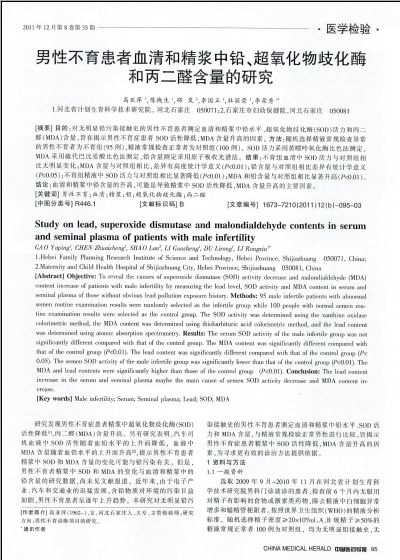男性不育患者血清和精浆中铅、超氧化物歧化酶和丙二醛含量的研究(1)
 |
| 第1页 |
参见附件。
[摘要] 目的:对无明显铅污染接触史的男性不育患者测定血清和精浆中铅水平、超氧化物歧化酶(SOD)活力和丙二醛(MDA)含量,旨在揭示男性不育症患者 SOD活性降低,MDA含量升高的因素。方法:随机选择精液常规检查异常的男性不育者为不育组(95例),精液常规检查正常者为对照组(100例)。SOD活力采用黄嘌呤氧化酶比色法测定,MDA采用硫代巴比妥酸比色法测定,铅含量测定采用原子吸收光谱法。结果:不育组血清中SOD活力与对照组相比无明显变化;MDA含量与对照组相比,差异有高度统计学意义(P<0.01);铅含量与对照组相比差异有统计学意义(P<0.05);不育组精液中SOD活力与对照组相比显著降低(P<0.01);MDA和铅含量与对照组相比显著升高(P<0.01)。结论:血清和精浆中铅含量的升高,可能是导致精浆中SOD活性降低,MDA含量升高的主要因素。
[关键词] 男性不育;血清;精浆;铅;超氧化物歧化酶;丙二醛
[中图分类号] R446.1 [文献标识码] B [文章编号] 1673-7210(2011)12(b)-095-03
Study on lead, superoxide dismutase and malondialdehyde contents in serum and seminal plasma of patients with male infertility
GAO Yaping1, CHEN Zhuaisheng1, SHAO Lan2, LI Guozheng1, DU Lirong1, LI Rongxiu1*
1.Hebei Family Planning Research Institute of Science and Technology, Hebei Province, Shijiazhuang 050071, China; 2.Maternity and Child Health Hospital of Shijiazhuang City, Hebei Province, Shijiazhuang 050081, China
[Abstract] Objective: To reveal the causes of superoxide dismutase (SOD) activity decrease and malondialdehyde (MDA) content increase of patients with male infertility by measuring the lead level, SOD activity and MDA content in serum and seminal plasma of those without obvious lead pollution exposure history. Methods: 95 male infertile patients with abnormal semen routine examination results were randomly selected as the infertile group while 100 people with normal semen routine examination results were selected as the control group. The SOD activity was determined using the xanthine oxidase colorimetric method, the MDA content was determined using thiobarbituric acid colorimetric method, and the lead content was determined using atomic absorption spectrometry. Results: The serum SOD activity of the male infertile group was not significantly different compared with that of the control group. The MDA content was significantly different compared with that of the control group (P<0.01). The lead content was significantly different compared with that of the control group (P<0 ......
您现在查看是摘要介绍页,详见PDF附件(2624kb)。